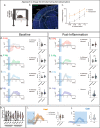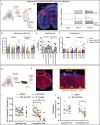The secondary somatosensory cortex gates mechanical and heat sensitivity
- PMID: 38346995
- PMCID: PMC10861531
- DOI: 10.1038/s41467-024-45729-7
The secondary somatosensory cortex gates mechanical and heat sensitivity
Abstract
The cerebral cortex is vital for the processing and perception of sensory stimuli. In the somatosensory axis, information is received primarily by two distinct regions, the primary (S1) and secondary (S2) somatosensory cortices. Top-down circuits stemming from S1 can modulate mechanical and cooling but not heat stimuli such that circuit inhibition causes blunted perception. This suggests that responsiveness to particular somatosensory stimuli occurs in a modality specific fashion and we sought to determine additional cortical substrates. In this work, we identify in a mouse model that inhibition of S2 output increases mechanical and heat, but not cooling sensitivity, in contrast to S1. Combining 2-photon anatomical reconstruction with chemogenetic inhibition of specific S2 circuits, we discover that S2 projections to the secondary motor cortex (M2) govern mechanical and heat sensitivity without affecting motor performance or anxiety. Taken together, we show that S2 is an essential cortical structure that governs mechanical and heat sensitivity.
© 2024. The Author(s).
Conflict of interest statement
C.J.W is a founder of Nocion Therapeutics, Quralis, and Blackbox Bio. Z.H. is a founder of Myrobalan Therapeutics and Rugen, and an advisor of Axonis. The remaining authors declare no competing interests.
Figures





Update of
-
The Secondary Somatosensory Cortex Gates Mechanical and Thermal Sensitivity.bioRxiv [Preprint]. 2023 May 22:2023.05.19.541449. doi: 10.1101/2023.05.19.541449. bioRxiv. 2023. Update in: Nat Commun. 2024 Feb 12;15(1):1289. doi: 10.1038/s41467-024-45729-7. PMID: 37293011 Free PMC article. Updated. Preprint.
-
The Secondary Somatosensory Cortex Gates Mechanical and Thermal Sensitivity.Res Sq [Preprint]. 2023 Jun 28:rs.3.rs-2976953. doi: 10.21203/rs.3.rs-2976953/v1. Res Sq. 2023. Update in: Nat Commun. 2024 Feb 12;15(1):1289. doi: 10.1038/s41467-024-45729-7. PMID: 37461707 Free PMC article. Updated. Preprint.
References
MeSH terms
Grants and funding
LinkOut - more resources
Full Text Sources
Molecular Biology Databases

